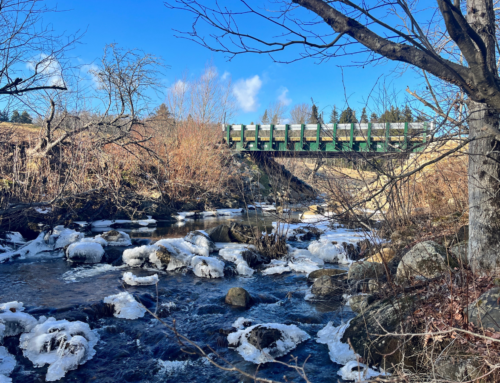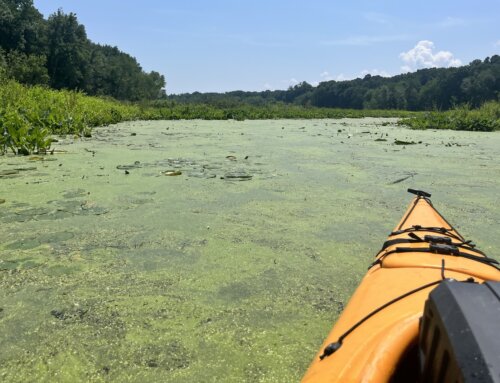Greenfield, MA – As weather begins to warm and people head outside for fresh air and exercise while remaining physically distant, Connecticut River Conservancy (CRC) urges people to use caution when swimming, boating, or fishing in rivers. In addition to rivers being swollen from spring rain and snowmelt, there’s an added concern about E. coli bacteria and coronavirus exposure from untreated sewage in rivers. Luckily, there’s one easy thing to keep in mind that is an indicator of river cleanliness – the weather, specifically if it has rained recently.

Caption: At sites sampled across all four Connecticut River states (including CRC sites and partner sites), over 90% of sites tested in dry weather were clean for swimming or boating, compared to just 85% clean for swimming or boating during wet weather.
Typical wastewater treatments involving chlorine or ultraviolet (UV) light are effective in killing E. coli bacteria and are expected to be highly effective in killing COVID-19. Therefore, CRC is primarily concerned about untreated sewage discharges into our rivers, which has always been a concern, even before COVID-19. Rain flushes all sorts of pollutants into our rivers and can overwhelm our aging stormwater infrastructure, causing sewage and polluted stormwater runoff to flow directly into our rivers. “Many years of Connecticut River E. coli bacteria testing data tell us that it’s a good idea to stay out of rivers for 24 to 48 hours after a heavy rain because bacteria levels could be high,” says Andrew Fisk, CRC executive director. The presence of bacteria is an indication that other germs that could make you sick – like coronavirus – may also be present. “While COVID-19 is a new threat, our recommendation to avoid rivers after heavy rain remains the same,” says Fisk.
Research is still underway to determine if COVID-19 remains infectious in freshwater or after passing through wastewater treatment facilities. Information available from the Center for Disease Control (CDC), the Environmental Protection Agency, and the Water Research Foundation indicates that the likelihood of catching COVID-19 from treated or untreated sewage is thought to be low. However, the CDC has noted that the SARS virus, also a type of coronavirus, was detected in untreated sewage for 14 days.
River users are encouraged to visit the “Is It Clean? / ¿Está limpio?” website at ctriver.org/isitclean to find bacteria test results — an indicator of overall river cleanliness — for nearly 200 river access and recreation sites in Vermont, New Hampshire, Massachusetts, and Connecticut. The site is also available in Spanish at ctriver.org/estalimpio. Water samples are collected from late-May through early-October. Current plans are for testing to resume as usual this year.
Each summer, CRC and more than 20 partner organizations deploy volunteers to collect water samples from popular boat launches and swimming holes. Samples are typically collected at each site weekly or bi-weekly, tested for E. Coli, and test results are posted online 24 hours later. Water sample results are color-coded and map-based so users can easily see where the river is clean. Results are a snapshot of river conditions at the moment the sample was taken, but give river users information they can use to make informed decisions. The website provides bacteria data for the Connecticut River and more than 20 tributaries, including the Chicopee River and Deerfield Rivers in MA, the Scantic River in CT, the Saxtons River and Black River in VT, the Ashuelot River in NH, and many more. Bacteria test results for 2019 showed nearly all sites sampled by CRC had dry-weather average bacteria levels below the limits considered safe for swimming and boating.
“Thanks to decades of investments and public opinion committed to investing in clean water, our rivers are certainly much cleaner than they used to be,” notes Fisk. “But it’s smart for river users to think about recent weather and check online resources like the ‘Is It Clean? / ¿Está limpio?’ website so they know when our rivers are clean enough for swimming or boating.” Many cities and towns along our rivers are making significant investments to separate the outdated combined sewer overflows (CSOs) into separate sewer and stormwater systems that can better handle all the water. Pollution from parking lots, farms, dog parks and more also contribute to the problem. Federal stormwater regulations require densely developed towns and cities to take measures to reduce pollution from street and parking lot runoff. These investments have made a tremendous difference in improving the health of our rivers and protecting river users.
About the Connecticut River Conservancy
Since 1952, Connecticut River Conservancy has been the voice for the Connecticut River watershed, from source to sea. They collaborate with partners across four states to protect and advocate for your rivers, to educate and engage communities. CRC brings people together to prevent pollution, improve habitat, and promote enjoyment of your river and its tributary streams. Healthy rivers support healthy economies. To learn more about CRC, or to join the effort and help protect our rivers, visit ctriver.org.
# # #
Additional resources:







